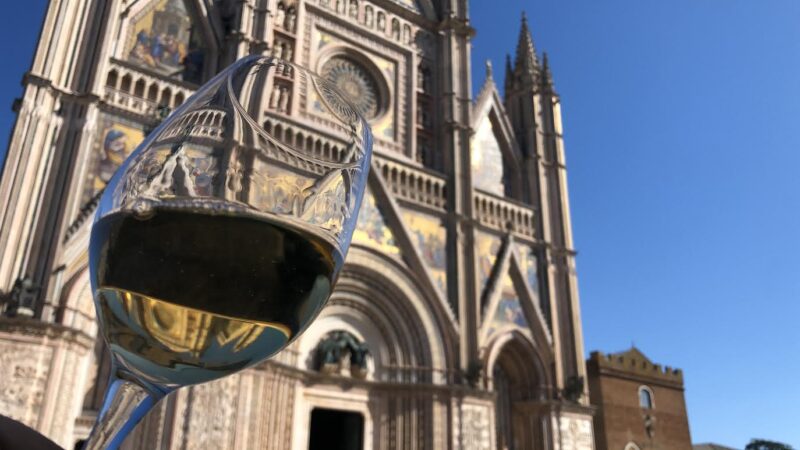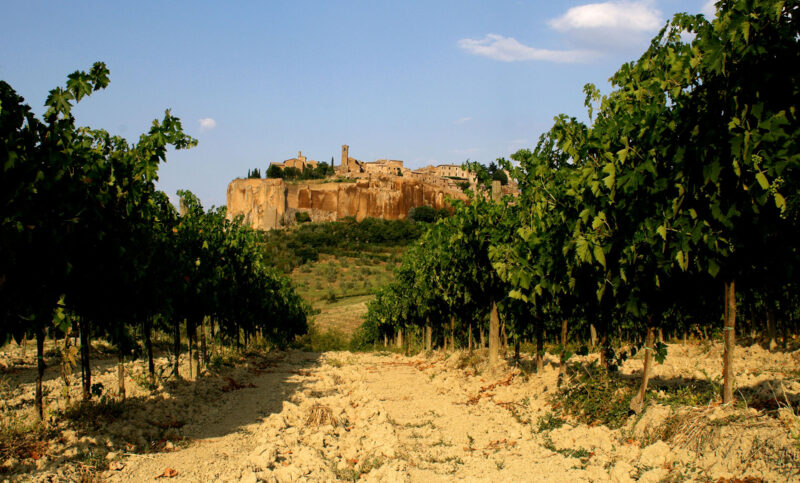
Vineyards with Orvieto in the distance. The city rests atop an outcropping of tufa and volcanic stone. Photo provided by the Consorzio Vino Orvieto.
Located in southern Umbria and bordering Lazio, Orvieto has a 3000-year-old history in wine production. In the 13th century Orvieto was a refuge for five Popes: Uban IV (1261–1264), Gregory X (1271–1276), Martin IV (1281–1285), Nicholas IV (1288–1292) and Boniface VIII (1294–1303). During that period Orvieto wines, favored by the papal court, grew in prominence. In the Middle Ages, Orvieto wine sales provided an important form of revenue. We learned during a guided tour that the Orvieto cathedral was partially funded by revenue from sales of Orvieto wines.
In 1971 the Orvieto DOC (Controlled Designation of Origin) was established. Production is allowed in the provinces of Terni and Viterbo, one of the oldest wine territories in Umbria. In the last 40 years, Orvieto has undergone an estate bottling revolution.
According to the Consortium for Orvieto Wines, “Until a few years ago, viticulture was traditional, with the presence of mixed cultivation, today it has been totally replaced with a complete restructuring of the vineyards: a higher planting density and training systems that allow for a lower quantity per plant and therefore better quality.”
The designation Orvieto Superiore was established 1997. These wines must have a minimum alcohol content of 12% and can only be put on the market after March 1 of the year following the harvest. Most of the Orvieto DOC wines we tasted ranged between 11.5%- 13% ABV.
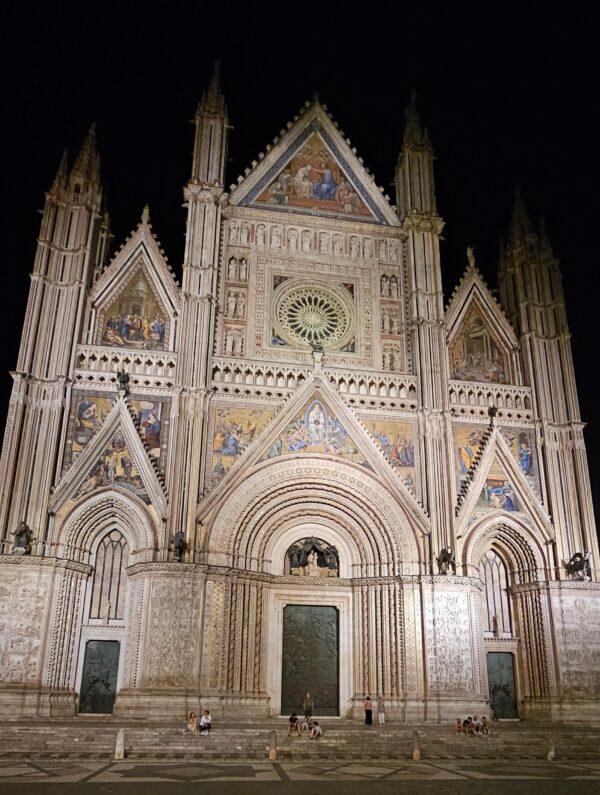
Orvieto Cathedral. The city sits atop a network of underground caves inside volcanic rock.
Four specific soils define the terroir that produces these diverse and nuanced wines: sand, clay, alluvial, and volcanic. Orvieto and Orvieto Classico DOC whites are all blends, minimum 60% Grechetto and Trebbiano Toscano (locally known as Procanico). These whites range from crisp and dry to aromatic and floral; many have a lower ABV under 13%. Orvieto DOC also produces Botrytis affected grapes (known as Orvieto Abboccato). These wines range from delicate and dry to layered and complex, off-dry and unctuous. These wines are also referred to as Muffa Nobile, meaning “noble rot.”
Orvietano Rosso DOC, established in 1998, is a smaller subzone producing blended reds, predominantly medium and fuller bodied in character. The main grape varieties (comprising 70% of the blend) can include: Aleatico, Cabernet Franc, Cabernet Sauvignon, Canaiolo Rosso, Ciliegiolo, Merlot, Montepulciano, Pinot Noir, Sangiovese. The secondary grape varieties (comprising up to 30% of the blend) can include: Aleatico, Barbera, Cesanese comune, Colorino and Dolcetto.
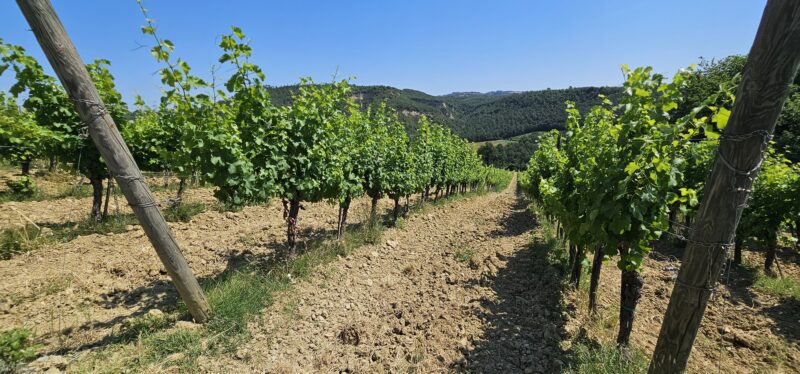
Vineyards at Argillae Winery in the northwest of Orvieto are characterized by clay and sand which also form the hilly slopes in the area known as “calanchi.” Photo: Melanie Young
A recent visit to Orvieto offered us a deep dive into the different production zones. We visited six wineries and met five more producers at a dinner organized by the Consorzio Vino Orvieto, who helped arranged our tours and tastings. We also visited several historic attractions that should be on everyone’s itinerary, including Orvieto Underground to visit the network of caves where wines were made and pigeons were cultivate for trade (among other activities). And, of course, we dined at several local restaurants and enjoyed plenty of pasta and bruschetta with shavings of Umbria’s famous black truffles.
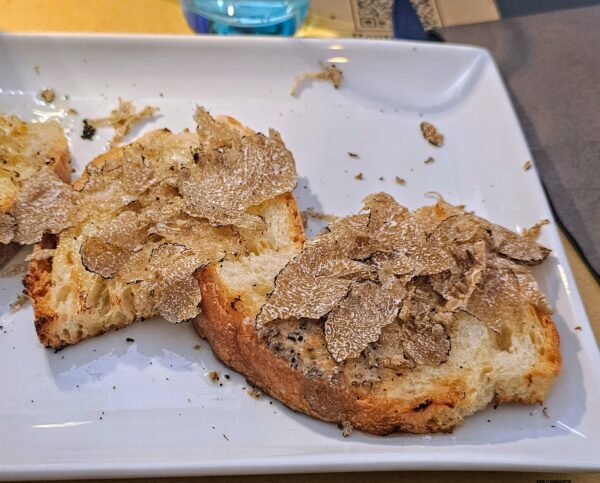
Summer black truffles can be found on many dishes in Orvieto shaved over pasta and bruschetta.
Our visit happened to coincide with the celebration of Corpus Domini to commemorate the Eucharist Miracle of Bolsena which occurred 1263 and involved a sacred bloodstained cloth- Sacro Corporale- which is housed in the Orvieto cathedral. There were processions and celebrations all over town, and residents wearing medieval costumes. Being local New Orleanians now, we never miss an opportunity to attend parades and felt very lucky to be in Orvieto during this special event. Read more on it here: Corpus Domini Orvieto | Orvieto
Maybe it’s a special sign for us that we will be spending more time in Europe!
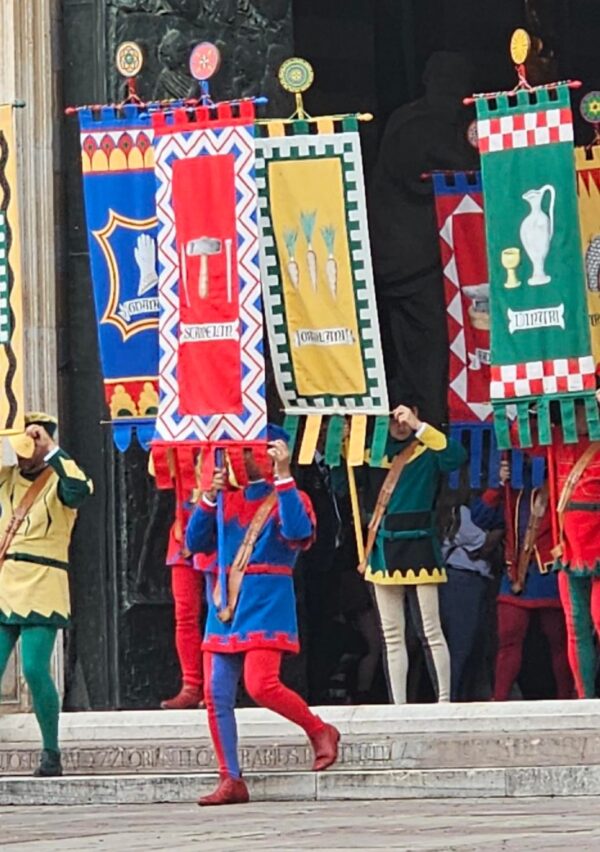
Corpus Domini Orvieto | Orvieto
Listen to this episode here on The Connected Table podcast
Watch on YouTube: The Connected Table TV
